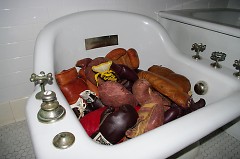At first glance, there is nothing about The Leonard at Logan Bed & Breakfast (440 Logan SE) that screams banal. The English-style bed & breakfast in Heritage Hill is an upscale destination for mini-vacations, weddings, business meetings and various social gatherings. The home, built in 1914, was owned by the prominent Harry C. Leonard during a time of social change and prosperity. Mr. Leonard was a successful businessman and philanthropist, but it was the women who surrounded him that inspired four current Grand Rapids artists to hone in on the historical value of the homestead.
Dorothy Leonard Judd, Mr. Leonard’s granddaughter, played an influential role with The League of Women Voters and led several major political changes. Less recognized, however, were the women who occupied the maids’ quarters and spent their days serving the Leonards.
In light of Women’s History Month, artists Mandy Burrow, Anna Campbell, Margie Erlandson and Alynn Guerra developed the idea for a show entitled Their Daily Bread, honoring the women who have played a significant role in Grand Rapids' history. The open house at The Leonard at Logan ran from March 26-28.
The tour began with Margie Erlandson’s work, which included a runner embroidered with excerpts from Dorothy Leonard Judd’s life memoirs. The piece, draped along the stairway, addressed memories and universal themes found in humanity. Erlandson’s second piece, a sewn dish towel installation, hung from the ceiling of the upstairs hallway. The towels alluded to the behind-the-scenes dirty work that goes into birth, boiling water and cleaning the birthing room. The pieces went hand-in-hand, honoring Judd’s compassionate nature and the women for whom she advocated.
The hallway led the viewer to the second floor maids’ quarters, which was in disarray. Dishes were unstacked, linens unironed and undergarments hung from the clothesline. This found-objects installation by Mandy Burrow reflected on the role of the domestic laborer during the 1930s and 1940s.
“While history and society might render them nameless bodies who served the wealthy class, I hope to portray them in a more intimate light,” Burrow said.
A closer look at the objects in the room revealed a more personal side of the maids' lives: magazines and devotionals laid haphazardly on the kitchen table. The items were invitations for viewers to experience maids' busy lives and their attempts to capture a moment to themselves.
Just down the hall from the maids’ quarters, Anna Campbell had transformed the washroom into a video and sculpture installation. A silhouette, projected onto the rib cage shower, was very muscular and androgynous, but clearly meant to be female. Speakers looped the sound of a shower, and boxing gloves were piled in an oversized bath. Campbell's piece was a response to the site and the intent of the exhibit. She played on the tension between genders and noted “the often blurriness and uncertainty of this distinction.”
The tour concluded with the downstairs sitting room, where Alynn Guerra had covered furniture in bedsheets stamped with newspaper prints. The articles were from The Grand Rapids Herald and spanned the Women’s Suffrage Movement from 1912-1920. Guerra pointed out that many important stories about women never made it to the front page and were seen as insignificant. In a more direct response to the site, Guerra’s stencils of news excerpts were also stamped on the floors throughout the house. Guerra used dust, flour, and ashes to acknowledge quotidian and banal tasks such as baking bread, and to pay respects to the dead who participated in the Women’s Suffrage Movement.
“We are still struggling to make changes,” Guerra said. That is the challenge: to learn from history and to strive for greater equality.
The Rapidian, a program of the 501(c)3 nonprofit Community Media Center, relies on the community’s support to help cover the cost of training reporters and publishing content.
We need your help.
If each of our readers and content creators who values this community platform help support its creation and maintenance, The Rapidian can continue to educate and facilitate a conversation around issues for years to come.
Please support The Rapidian and make a contribution today.
Related Articles
Comments, like all content, are held to The Rapidian standards of civility and open identity as outlined in our Terms of Use and Values Statement. We reserve the right to remove any content that does not hold to these standards.



